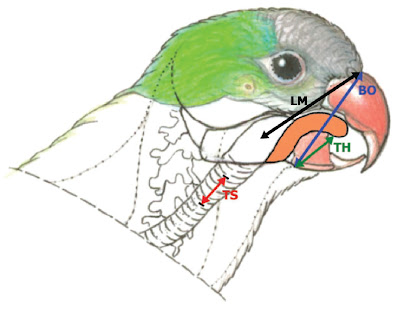 |
| A Quaker parrot shows off his beak and tongue. Photo by Alex Nelson at Wikimedia Commons. |
Here is an example of an African grey parrot producing sound :
Humans produce sound by using their vocal tract, which includes the larynx (known as the voice box), where the vocal folds are located. Sound is produced with the help of the trachea, which controls air flow through the larynx. In the larynx the vocal folds make sound by vibrating. The remainder of the vocal tract includes the throat, nose, tongue and lips which are involved in the articulation of speech. On the other hand, parrots have a syrinx (what rivals the larynx), a trachea, a tongue and a beak. This means that birds do not have vocal cords to produce the sounds that we as humans make; they instead have two air passages that come together at the organ known as the syrinx creating a vibration that produces sound.
From my experiences working with and owning a variety of parrots, I would say that African grey parrots and monk parakeets (also known as Quaker parrots) are the two clearest and best mimicking parrots. Quaker parrots originate from South America. Over the years these birds have learned to adapt to their environment extremely well, leading to the birds becoming an invasive species in many parts of the world, including several U.S. states where they are now illegal to own as pets.
Research done by Verena Ohms, Gabriël Beckers, Carel ten Cate and Roderick Suthers recently set up a study using x-ray imaging to determine what is taking place in the vocal tract of a Quaker parrot while producing species specific calls. To do this, a piece of metal wire was placed on the underside of a Quaker parrot’s tongue and two pieces of wire were placed inside the trachea attached to tracheal rings. Here is an example of what researchers were looking at which allowed them to monitor the bird’s tongue, beak, and trachea movements.
Researchers looked specifically at a few measures when a bird produces sound: the bird’s tongue height (TH), the size of the beak opening (BO), and the amount of tracheal stretching (TS).
 |
| Diagram of the measures taken from Quaker parrots. Figure from Ohms, et al., 2012. |
So whether my trouble-making parrot (you should hear him burp and excuse himself) is blowing me a kiss or mimicking a bird song, there are many similarities in the way that humans and parrots produce speech sounds. This is pretty amazing for two groups of animals that are so different!
Work Cited
Ohms, V., Beckers, G., Ten Cate, C., & Suthers, R. (2012). Vocal Tract Articulation Revisited: The Case of the Monk Parakeet The Journal of Experimental Biology, 215, 85-92 DOI: 10.1242/jeb.064717

Nice work Porscha! Great job of pulling lots of information together in a small space.
ReplyDeleteDr. B
wow. good information :)
ReplyDeleteWhen are you going to post again? You really entertain me!
ReplyDelete